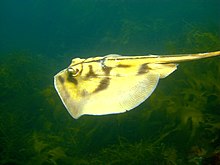Urolophidae
| Urolophidae | |
|---|---|

| |
| Crossback stingaree (Urolophus cruciatus) | |
| Scientific classification | |
| Domain: | Eukaryota |
| Kingdom: | Animalia |
| Phylum: | Chordata |
| Class: | Chondrichthyes |
| Subclass: | Elasmobranchii |
| Superorder: | Batoidea |
| Order: | Myliobatiformes |
| Suborder: | Myliobatoidei |
| Superfamily: | Urolophoidea |
| Family: | Urolophidae J. P. Müller & Henle, 1841 |
| Genera | |
| |
The Urolophidae are a
Stingarees feed on or near the
Taxonomy and phylogeny

The German biologists Johannes Müller and Jakob Henle created the genus Urolophus in 1837;[1] in their subsequent 1838–41 Systematische Beschreibung der Plagiostomen, the pair created the genus Trygonoptera and also made the first reference to the urolophids as a group.[2] The family has traditionally also included the genera Urobatis and Urotrygon of the Americas; John McEachran, Katherine Dunn, and Tsutomu Miyake moved them to their own family, Urotrygonidae, in 1996.[3]
Recent
Distribution and habitat

The center of
Description

Stingarees are modestly sized, ranging from 30 to 80 cm (12 to 31 in) long. They have greatly enlarged
The
Biology and ecology

Stingarees are slow swimmers that can often be found lying still on the bottom, sometimes partly or completely buried in
Like other myliobatiforms, stingarees have a
Human interactions
Though generally innocuous towards humans, when disturbed stingarees can inflict a painful wound with their stout,
References
- ^ Müller, J. & F.G.J. Henle (1837). "Gattungen der Haifische und Rochen nach einer von ihm mit Hrn. Henle unternommenen gemeinschaftlichen Arbeit über die Naturgeschichte der Knorpelfische". Bericht Akademie der Wissenschaften zu Berlin. 1837: 111–118.
- ^ Müller, J. & F.G.J. Henle (1838–1841). Systematische Beschreibung der Plagiostomen. Veit und Comp. p. 173–174.
- ISBN 978-0-12-670950-6.
- ISBN 0-471-25031-7.
- ^ McEachran, J.D. & N. Aschliman (2004). "Phylogeny of Batoidea". In Carrier, J.C.; J.A. Musick & M.R. Heithaus (eds.). Biology of Sharks and Their Relatives. CRC Press. pp. 79–114.
- ^ a b Séret, B. & P.R. Last (2003). "Description of four new stingarees of the genus Urolophus (Batoidea: Urolophidae) from the Coral Sea, south-west Pacific". Cybium. 27 (4): 307–320.
- ^ ISBN 0-674-03411-2.
- ^ ISBN 92-5-104302-7.
- ^ .
- ^ Fowler, H.W. (1941). "Contributions to the biology of the Philippine Archipelago and adjacent regions". Bulletin of the United States National Museum. 100 (13): 1–879.
- doi:10.1071/mf04225.
- ISBN 0-930118-18-9.
- .
- .
